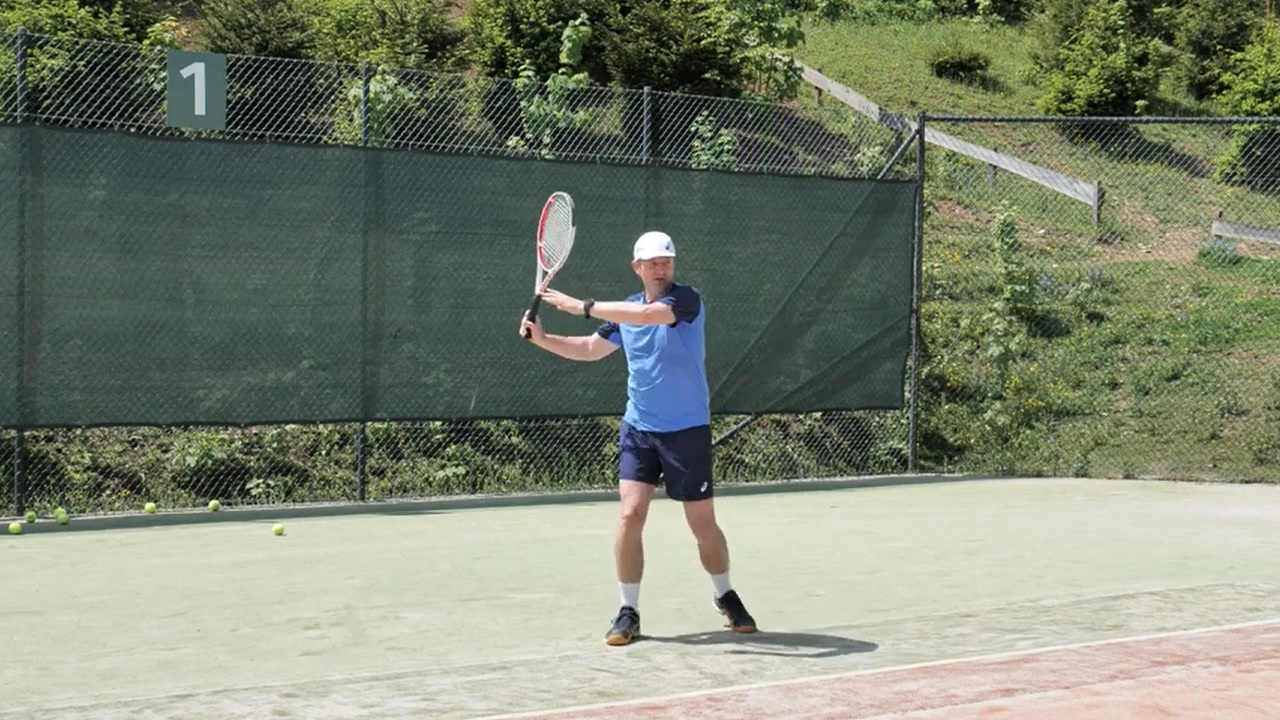Based on my experience, the following tennis forehand tips are the most effective in helping players achieve consistency and accuracy in their forehands.
While the forehand stroke is usually a weapon with which we create lots of pressure and hit winners, it’s also a very complex shot and it’s easy for things to go wrong.
So your first objective when working on the forehand is to make sure it’s reliable and accurate and once your technique is solid, you can focus on adding more power and spin to take your game to the next level.
Image credit: Thanks to Ian Westerman from Essential Tennis for letting me use pro footage and images in this post.
1. Stabilizing The Wrist And Quieting The Racket
The first thing that can go wrong and set your forehand on the wrong path is the position of the wrist as you start the preparation.
Tennis players tend to do one of two things incorrectly:
a) Their wrist is too loose, and the racket flails around too much during the stroke, causing the player to lose control of the shot.
b) Their wrist is too stiff, as they will the wrist is not stable by itself and they try to control the wrist with stiffness, and they lose power of the shot.
In both cases, the cause is very similar - the player does not feel a stable wrist at the start of the forehand.
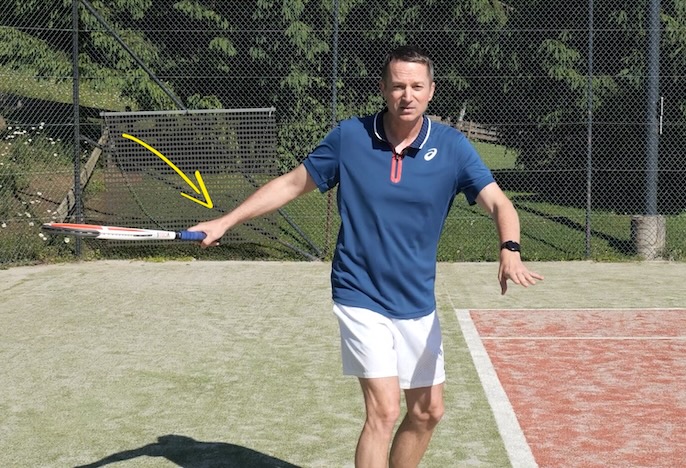
If you start your forehand with a stiff or loose wrist, you will not have a reliable forehand.
In order to stabilize and “calm down” the wrist, hand, and the racket head, we need to gently lay back the wrist to the point where it stops moving.
In other words, we create a wrist extension, and we do that by using our non-dominant hand with which we push the racket head and the hand backwards.
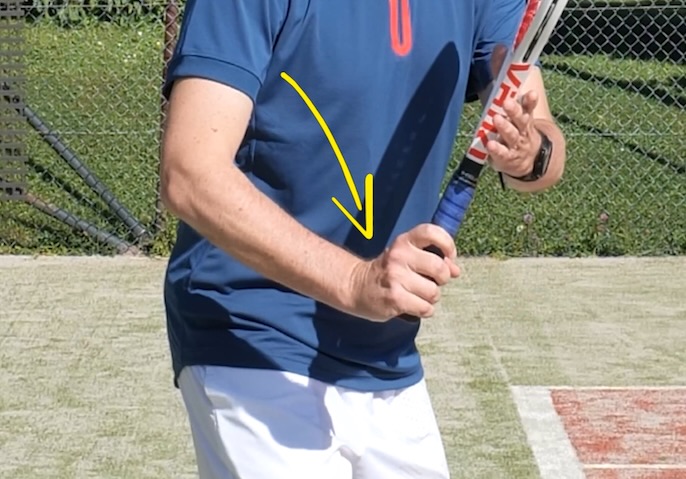
Bend your wrist with the help of the non-dominant hand as soon as you start the preparation.
That way, the wrist will reach the end of its range of motion and stabilize there.
You should NOT feel stiff in that position but just that the wrist, hand, and racket have stopped moving around. The wrist should feel stable and comfortable.

Even though Roger Federer relaxes his wrist later in the forehand swing, he still sets it up in a bent position.
2. Enhancing Racket Awareness
Racket awareness is all about knowing where your racket is in space and how it’s oriented.
And racket awareness is crucial for controlling your forehands or any other stroke because you need to guide the racket towards the ball at the right time and at the correct orientation in space.
To better understand what racket head awareness is, place both hands on the string bed of the racket one on each side like in a sandwich.

Try this in your living room now and note how well aware you are of the racket orientation in space.
Then turn the racket around in space in different ways and notice how well aware you are of its orientation in space.
The goal is to come as close as possible to this feeling also when we’re preparing our forehand stroke.
And the way we do it is that we hold with the non-dominant hand at the throat of the racket for a long time into the preparation.
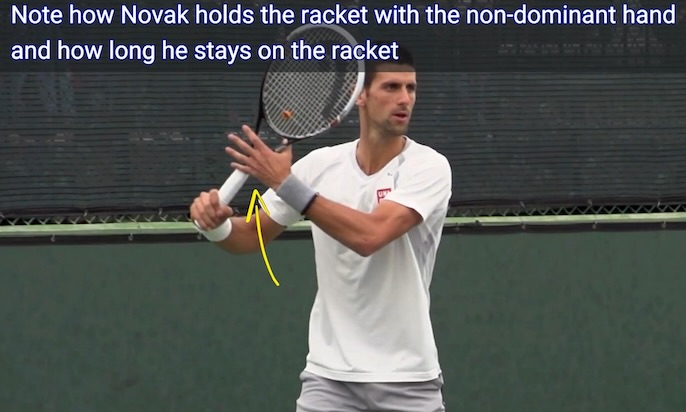
I am showing you Novak Djokovic here as an example but basically every pro does this...
Not only does that way of using the non-dominant arm improve racket head awareness, it also improves your coiling and consequently the uncoiling which is one of the sources of power.
3. Whole Body Rotation for Power and Control
The single most common mistake players make when hitting a forehand is keeping their hips back.
While this is often caused by poor timing and players hitting the ball late, we can correct this mechanically, and the timing often improves too.
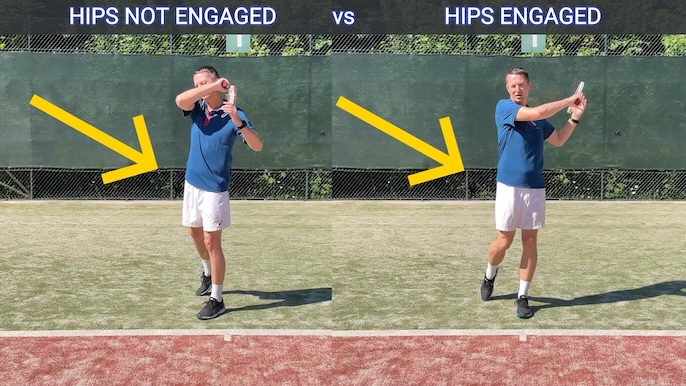
I correct the lack of hip rotation on the forehand almost every week...
Not rotating hips into the shot causes your body to be disconnected and very uncomfortable as the shoulders rotate forward but the hips don’t.
And because the body is very uncomfortable and tense, that results in very poor ball control and very weak strokes.

Hips / pelvis connect the lower and the upper body and they HAVE to engage in the stroke.
It’s crucial that you rotate your hips / pelvis into the ball together with the upper body as they will make your forehands much more effortless and much easier to control.
4. The Often-Overlooked Importance of Balance
Remember this saying in tennis:”If you cannot control your body, you cannot control the ball.”
Tennis players focus too much on what their arms are doing (mostly because of poor coaching), while neglecting what their feet are doing and whether they feel stable when hitting the ball.
If you are not stable when hitting the ball, your stroke will be “unstable”; it’s that simple.
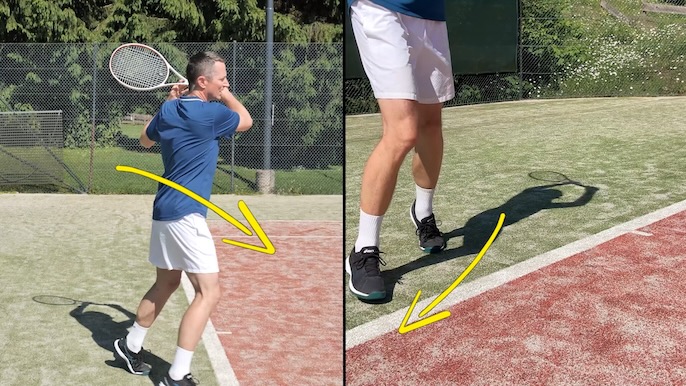
Poor balance in tennis leads to poor ball control.
While it’s true that we cannot always stabilize ourselves if, for example, we have to hit a running forehand, we still can do a much better job in most other situations.
There are three typical ways we hit a forehand stroke in tennis, and I will show you an example of how to practice stabilizing yourself for each.
a) Neutral stance forehand - keep the front foot on the ground for the duration of the stroke, just like you see Del Potro demonstrating this very nicely.

Keep your heel down in a neutral stance forehand on a nice incoming ball.
b) Open stance forehand with weight transfer - feel the stability of the right foot on the ground (for right-handers) before the stroke and then the stability of the left foot fully on the ground at the end of the forehand, just like you see Federer demonstrating.
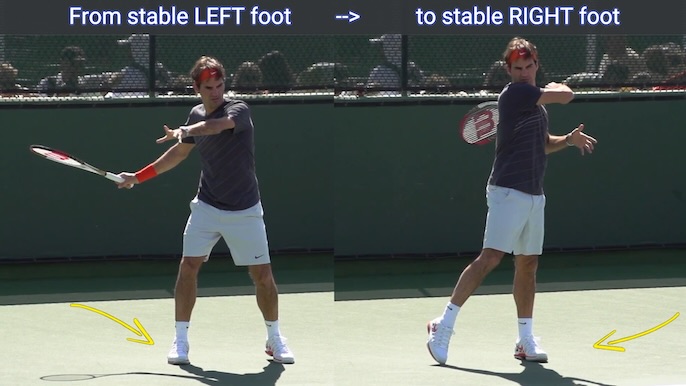
Feel the stability at the start and at the end of the stroke.
c) Open stance without the weight transfer - in this case, there is no weight transfer going into the ball while we are hitting the forehand, so it’s crucial that we feel very stable on the right leg as we are hitting the forehand. The weight transfer will happen a bit later as the body’s momentum pulls you back to the left leg.

Note how stable Novak Djokovic is on the right foot.
5. Using Different Contact Points for Directional Control
Controlling the direction of your forehand—whether you’re aiming cross-court or down the line—isn’t about changing the angle of your wrist or racket face. Many players try to do that, but it can lead to unstable shots.
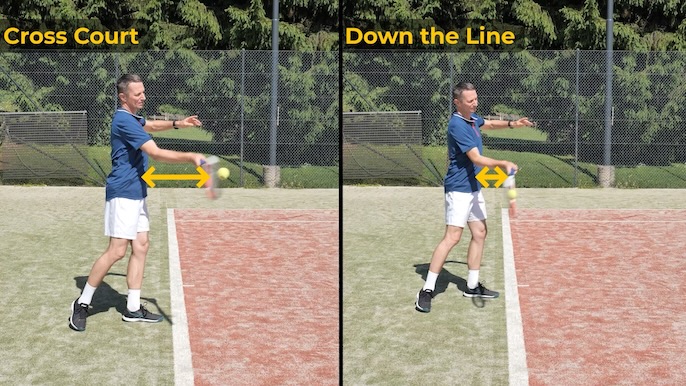
Note the difference in the distance to the contact point...
Instead, focus on adjusting the timing of when you hit the ball. For a cross-court shot, strike it a bit earlier and closer to your body; for a down-the-line shot, wait a fraction longer and hit it a bit further out.
While this may not be easy at first as it requires very accurate timing, once you master it you can hit very reliable and accurate forehands in any direction.
Conclusion
The reason why included these specific tennis forehand tips in this article is because I use them almost on a daily basis as I work with players on improving their forehands.
In most cases they are not preparing the right way (unstable wrist and not helping enough with the non-dominant hand), they are not stable enough as they are setting up for the shot and they don’t rotate their hips into the ball losing on power and control.
When we succeed is correcting these key elements of the forehand technique, the player realizes that they now have access to easy power and very good control of their shots.
And only when your forehand is a very stable and reliable stroke do I recommend that you take it to the next level by improving all sources of power which is what the free Forehand Power Course is all about.




